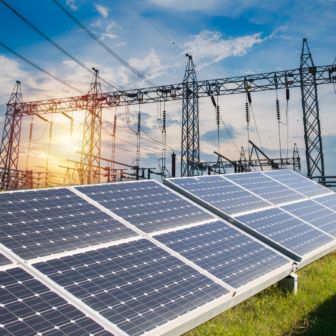Recently, a few individuals have published questions about offshore wind power. Some of their main concerns were:
1) Does it really reduce emissions?
2) Will it help us achieve a future zero-carbon grid?
3) Will it be affordable for ratepayers?
Thankfully, ample scientific evidence and real-world experience provide answers to these questions. Indeed, wind power can and will continue to reduce emissions by displacing fossil fuels, wind power can be part of a future zero-carbon grid, and other states have found long-term offshore wind power contracts to be affordable for their rate payers. Offshore wind power in particular is one of the greatest answers for Maryland and the world’s energy future.
The following post provides answers to these questions based on reliable data and studies. More information about offshore wind can be found on the Marylanders for Offshore Wind website.
1. Does wind power reduce overall emissions in an electric system?
Yes, it is clear that wind power reduces overall emissions for energy systems by displacing fossil fuels.
Here is a collection of data and research proving the power of wind to reduce emissions from electricity:
A) According to the DOE (U.S. Department of Energy), coal consumption fell in Denmark from 16.6 million short tons in 1996 to 7.8 million short tons in 2008 as more wind power was brought on line. In the same period, carbon dioxide emissions fell by over 20 million tons!
B) From Energinet.dk , Denmark’s state-owned energy enterprise (Page 24 of their Environmental Report 2007): “Greenhouse gas emissions vary a great deal from year to year, depending on electricity trading. When adjusting for imports and exports, the result is an overall emissions reduction of 21% in the 1990-2006 period. The primary reason is a conversion of Danish electricity and heat production to less CO2 intensive fuels such as natural gas and increased use of renewable energy sources.”
C) The journal, Energy Policy , found that offshore wind power produces fewer emissions over its life cycle ((9 g CO2e/kWh) than any other power source today. For comparison, Nuclear averaged (66 g CO2e/kWh), natural gas (443 g CO2e/kWh), and coal (960-1050 g CO2e/kWh).
D) According to PJM , the mid-Atlantic grid operator, wind power could save 1,628 pounds of CO2 per megawatthour of wind energy.
E) Data from the DOE show us that as renewable generation, mostly from wind, grew in Colorado from 2.5% of the state’s electricity in 2007 to 6.1% of the state’s electricity in 2008, CO2 emissions decreased by 4.4% and SO2, and NOX each decreased by 6% (data reports here and here ; also summarized in a report by AWEA ).
F) Also, DOE data show that as renewable energy, mostly form wind, grew in Texas from 2.9% of the state’s electricity in 2007 to 4.6% of the state’s electricity in 2008, CO2 and SO2 decreased by about 2% each, and NOx decreased by 13 percent (data here and here ).
G) One recent wind-critic blog cited data that both Colorado and Texas increased their net imports of out-of-state electricity from 2007 to 2008. However, these facts by no means prove that wind power was not responsible for reducing the need for fossil fuel generation and thereby decreasing emissions. If you look at the data, net interstate electric imports in each state have fluctuated many times over the past decade. While electric imports did increase in Colorado, so did the total disposition of electricity (data here ). This means that an increase in demand may have been the reason for an increase in imports, and had renewable energy not been brought online, more fossil fuel generation would have been necessary. If you account for imports and exports from 2007 to 2008, the percentage of generation for and by Texas that was fossil fuels decreased by 1.5 percent, even if you assume all imports to the state were from fossil fuels; this is almost the exact amount that renewable energy increased in-state from 2007 to 2008. The net change was clearly less fossil fuel generation and less emissions and part of the reason for this reduction must be credited to renewable energy, including wind (data here and here ). While some wind-critics may be well intentioned, we must, again, avoid paralysis analysis. Europe has utilized offshore wind for electricity since 1991 and Europe has also seen great emissions reductions . It’s proven: let’s get it going here.
H) DOE found that obtaining 20% of the nation’s electricity by 2030 would reduce carbon dioxide emissions by 25%.
No matter how you look at it, the data from reliable sources concludes that integrating wind power and renewable energy into electric systems has reduced emissions and will continue to do so.
A Bentek anti-wind report and some other studies criticizing wind were funded by the fossil fuel industry . More importantly, the studies miss the forest for the trees. The Bentek study, for example, focuses on one part of the energy system (instances of cycling coal plants operating less efficiently) and misses the overall effect of wind and renewable energy on our energy systems. Here are more articles about the proven effectiveness of wind in reducing emissions: Setting the Record Straight on Wind Energy By Frank Prager, Vice President of Environmental Policy at Xcel Energy The Facts About Wind Energy and Emissions By Michael Goggin, Transmission Policy Manager at AWEA Wind Power Always Replaces Fossil Fuels By Chuck Kleekamp, form
er President of Clean Power Now
2. Can wind power be part of a future zero-carbon grid?
While our main goal now is to reduce emissions as much and as quickly as possible, there are technological scenarios in which wind power will be part of a future zero carbon energy system.
Some wind skeptics argue that because wind power is variable, it will always need to be combined on the grid with a fossil-fuel source, like natural gas, that can be ramped up as needed to meet demand. Again, while natural gas is currently one of our best load following /peaking power options (renewable hydropower is another), there are technological scenarios in which we could eventually achieve a zero carbon grid with wind power.
In October 2009, Stanford University Professor Mark Jacobson and University of California – Davis Research Scientist Mark Delucchi published a paper in Scientific American titled “A Path to Sustainable Energy by 2030″ [PDF] . They also developed an interactive web feature published on ScientificAmerican.com to explain their work. They offer a number of ways a 100% renewable grid could mitigate the variability factor. From their paper:
“The main WWS (Wind, Water, and Sun) challenge is that the wind does not always blow and the sun does not always shine in a given location. Intermittency problems can be mitigated by a smart balance of sources, such as generating a base supply from steady geothermal or tidal power, relying on wind at night when it is often plentiful, using solar by day and turning to a reliable source such as hydroelectric that can be turned on and off quickly to smooth out supply or meet peak demand. For example, interconnecting wind farms that are only 100 to 200 miles apart can compensate for hours of zero power at any one farm should the wind not be blowing there. Also helpful is interconnecting geographically dispersed sources so they can back up one another, installing smart electric meters in homes that automatically recharge electric vehicles when demand is low and building facilities that store power for later use.”
Before the other options, variability is mitigated simply by predicting the weather/wind. Referencing sources from PJM to NREL, Environment Maryland [PDF link], found:
“Wind energy is a predictable resource. While the wind doesn’t blow with equal strength at all times, winds can be forecast with more than 80 percent accuracy a day in advance, allowing grid operators to plan ahead and ensure that enough capacity is available to keep the lights on.96 PJM, the regional electric grid operator, currently assigns new wind projects an initial “capacity credit” of 20 percent, meaning that 10 MW of wind power capacity offsets 2 MW of fossil fuel capacity for reliability planning purposes.97 PJM then updates this initial capacity credit for each individual wind farm based on actual operating experience, taking a rolling 3-year average of the power sup- plied by the facility during the hours of 3 p.m. to 7 p.m. from June 1 to August 31.98 Offshore wind projects, often in areas with winds that tend to blow more consistently, can have capacity credits as high as 40 percent.99″
This issue was also covered in a November post on SkepticalScience.com, titled “Renewable Baseload Energy .” This post discusses forms of renewable baseload energy (concentrated solar thermal) and promising storage opportunities to overcome the variability issue (i.e. store extra power produced during non-peak times for use during peak hours). While these technologies are available today, we need to continue to invest in research and development for storage and other renewable technologies.
As Joe Romm explains in his post, “How the world can stabalize at 350 to 450 ppm: The Full global Warming Solution ,” wind power is part of our path to a zero-carbon grid. Other renewable sources, such as solar, geothermal and tidal energy will play a role along with greater efficiency. As we work towards zero-carbon, natural gas will play a role as while it emits carbon, supply is uncertain and mining degrades the environment, it is a flexible fuel that emits much less than coal. Carbon capture and sequestration could have a role to play as the technology develops and the price comes down. While there are a number of issues from mining to security, nuclear power could play a role as well , especially with next generation technology that reduces waste. From a public policy perspective, it makes sense to pursue the safest and cleanest options first and foremost. Clearly, wind power is a safe and effective choice for generating power with zero emissions.
3. Is offshore wind power affordable for rate payers?
CCAN’s executive director, Mike Tidwell, published an op-ed in the Baltimore Sun this past week answering this very question.
The Public Service/Utility Commissions in Delaware and Massachusetts have approved contracts for offshore wind, finding them to be affordable to their state rate payers.
In the past decade, Maryland electricity rates have risen more than 75 percent due in large part to wildly fluctuating fossil fuel prices [Environment Maryland Offshore Wind Report – PDF ]. Offshore wind power offers reliable prices as the fuel (wind) is free and the rate can be locked in over a 25-year period. In 2008, the Delaware Public Service Commission found that the rate impact of a new wind contract was likely to be minimal and could ultimately save money in the case of rising fossil fuel rates and an inevitable price on carbon dioxide pollution [PSC Independent Consultant Report – PDF ].
Offshore wind power is affordable to rate payers, and when all of the benefits (including more jobs and a safer environment) are taken into account, promoting the resource becomes a slam-dunk public policy opportunity.




